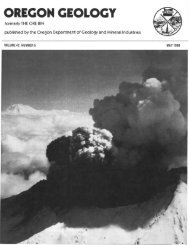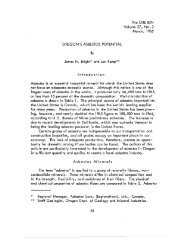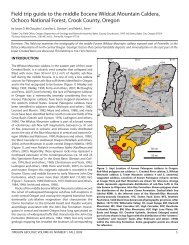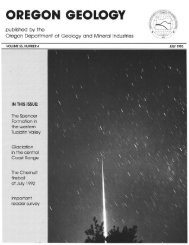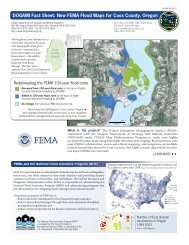Ore Bin / Oregon Geology magazine / journal - Oregon Department ...
Ore Bin / Oregon Geology magazine / journal - Oregon Department ...
Ore Bin / Oregon Geology magazine / journal - Oregon Department ...
You also want an ePaper? Increase the reach of your titles
YUMPU automatically turns print PDFs into web optimized ePapers that Google loves.
of the Sardine Formation in the roadcuts, The North Santiam<br />
mining area is approximately 3 mi to the north. Signs of hydrothermal<br />
alteration are common in the area. and epidote-lined<br />
fractures and propylitic alteration are typically noted.<br />
/0.2 mi (/.0 mi) A large dike crops out near where the road<br />
swings to follow the cirque wall to the east.<br />
lOA mi (0.2 mil Stop 8. Overlook of Opal Lake, the<br />
headwaters for Opal Creek. which joins Battle Ax Creek at<br />
Jawbone Flats to form the Little North Santiam River. Opal<br />
Lake occupies a cirque, and Opal Creek plunges over a series of<br />
three falls for a total drop in elevation of nearly 170 m. The<br />
upper falls is less than 0.25 mi northeast of the lake. The<br />
outcrops at this stop are bedded pyroclastic rocks that are<br />
probably rhyodacitic in composition. On the basis of White's<br />
( 1980b) lithologic descriptions, similar stratigraphic position.<br />
and elevation. it appears that these rocks are part of the Elk<br />
Lake formation. The o utcrops are well-layered, coarse<br />
heterolithic fragmental units of weathered, light-colored units<br />
interlayered with dark-colored. fragmental units of uniform<br />
clast types. The rocks are cut by a zeolite-coated fracture set that<br />
trends N. 40" W. and dips 70" SW. The fracture orientation isa<br />
common orientation encountered in the North Santiam mining<br />
area. The volcaniclastic rocks are intruded by subvolcanic<br />
inlrusions that cut the bedding at various angles.<br />
1l.6 mi (/.2 mi) White (1980b) mapped the crest of French<br />
Creek Ridge as the Elk Lake formation unconformably<br />
overlying rocks of the Sardine Formation. The thickness of the<br />
Elk Lake formation is ISO m atlhis locality. White defined two<br />
members of the formation: the lower consists of rhyodacitic<br />
flows and pyroclastic rocks, the upper of one or more thick<br />
flows of hornblende andesite. The pyroclastic units of the lower<br />
member are white or pale-pink'crystal-lithic tuff: flows are light<br />
gray and generally are flow banded. These lavas were probably<br />
erupted from a vent complex at the southwestern end of French<br />
Creek Ridge. This vent complex is the knob immediately<br />
southeast of the road at the crest of Frcnch Creek Ridge, White<br />
indicates that a small dome can be seen to intrude and to overlie<br />
the Sardine lavas at this point. A spine that is 10 m high occurs<br />
near the center of the dome. The upper member of the Elk Lake<br />
formation overlies the rhyodacitic rocks in the prominent knobs<br />
northeast of the pass at Martin Buttes and Byers Peak. These<br />
prominences are underlain by a single andesitic flow that is60 m<br />
thick and that displays a prominent colonnade. The andesites<br />
BOOK REVIEW<br />
by Daniel M. Johnson, Associate Professor 0/ Geography.<br />
Geography <strong>Department</strong>, Porrland State University. Portland.<br />
<strong>Ore</strong>gon 97207<br />
The Legacy of Ancient Lake Modoc: A Historical Geography of<br />
the Klamath Lakes Basin. by Sam and Emily Dicken, published<br />
by the authon, available from the University of <strong>Ore</strong>gon<br />
Bookstore,895 E. 13th, Eugene, OR 97403, or Shaw Stationery<br />
Company, 792 Main St" Klamath Falls. OR 97601. Price $10.<br />
For nearly 40 years, geographers Sam and Emily Dicken<br />
have been exploring and studying their adopted stale of <strong>Ore</strong>gon.<br />
They have shared the results of these efforts with the public<br />
through a series of books and <strong>journal</strong> articles. beginning with<br />
the first edition of <strong>Ore</strong>gon Geography published in 1950. In<br />
recent years we have been treated to Two Centuries 0/ <strong>Ore</strong>gon<br />
Geography: Vol I .• The Making 0/<strong>Ore</strong>gon(1979) and Vol. 2, A<br />
Regional Geography (1982). Their work on the historical<br />
geography of <strong>Ore</strong>gon has now been continued in a newly<br />
published book entitled The ugacy 0/ Ancient Lake Modoc: A<br />
contain abundant phenocrysts of plagioclase and less abundant<br />
but common phenocrysts of augite. Hypersthene and remnants<br />
of probable amphibole crystals are sparsely present as<br />
phenocrysts. The Elk Lake formation overlies both the Sardine<br />
and Breitenbush Formations with strong angular unconformity.<br />
Two K-Ar whole-rock ages for rocks of the Elk Lake formation<br />
are 9.8±O.46 m.y. and 11.8±0.4 m.y. (White. I 980b).<br />
13.3 mi (1.7 mil Stop 9, At this switchback, medium- to<br />
coarse-gra ined quartz diorite dikes intrude fine-grained ash<br />
beds of the Sardine Formalion. Hydrothermal alteration<br />
around the dikes has produced zeolitic alteration of the tuffs.<br />
Near the contact. the replacement is extensive but decreases in<br />
intensity away from the contact where the development of<br />
zeol ites becomes confined to fracture fillings and breccia<br />
cement. Analysis by X-ray diffraction indicates that laumontite<br />
is the main zeolite present. The contacts of the dikes are chilled<br />
against the wall, and xenoliths of tuff are incorporated into the<br />
dike. Abundant fine-grained xenoliths occur in the dike but,<br />
except for those near the contacts. are not derived from the<br />
immediate wall rocks. The contact strikes N. 10" W. and dips<br />
75" NE. Feldspar phenocrysts are strongly fractured, suggesting<br />
shattering such as might occur during hydrofracturing. These<br />
intrusions were emplaced at shallow depths.<br />
14.2 mi (0.9 mil Overview of Sardine Mountain, the type<br />
locality of the Sardine series as defined by Thayer (1939).<br />
Sardine Mountain is an eroded vent complex. Thin flows.<br />
bedded cinders. and radial dikes are considered to be a typical<br />
vent-facies assemblage exposed on the northern and western<br />
sides of the mountain (White. 1980b). On Hall Ridge<br />
immediately south of Sardine Mountain. flows are generally<br />
porphyritic, containing abundant plagioclase phenocrysts and<br />
lesser amounts of mafic phenocrysts. Most of the andesites have<br />
hypersthene and augite as phenocrysts. Lava flows compose<br />
from 50 to 70 percent of the formation in areas away from the<br />
vent complex. The rest of the formation is composed of lahars<br />
and lapilli tuff.<br />
l8A mi (4.2 mil Intersection with USFS Road 2223.<br />
Continue straight ahead. The sharp turn to the right would take<br />
you up Sardine Mountain to Tumble Lake.<br />
/8.6 mi (0.2 mil Intersection with <strong>Ore</strong>gon Highway 22, Turn<br />
right to return to Salem or le/t to go to the towns 0/ Detroil.<br />
Breitenbush Hot Springs, or Bend. 0<br />
Historical Geography 0/ the Klamath Lakes &sin (copyright<br />
1985 by the authors). This book represents a delightful blend of<br />
the two disciplines. but it differs from the Dickens' earlier work<br />
in that it focuses on one region of the state, the Klamath Lakes<br />
basin of south-central <strong>Ore</strong>gon. It amounts to a chronological<br />
description of both natural and human features. beginning with<br />
the period of exploration in the early 19th cen tury and<br />
continuing to 1985. Throughout. the authors have given careful<br />
attention to the perceptions of the region by those whoexplored<br />
and settled it.<br />
In the first chapter, the Dickens present an overview by the<br />
interesting technique of escorting the reader on an imaginary<br />
airplane flight. Only from this lofty perspective can the unity of<br />
the Klamath Lakes region be appreciated. As they point out. the<br />
"unifying feature is the lake plain. the bed of Old Lake Modoc.~<br />
a Pleistocene lake whose shoreline was drawn for the first time<br />
by Sam Dicken in an article in the November 1980 issue of<br />
<strong>Ore</strong>gon <strong>Geology</strong>. Modern lakes of the region. including<br />
<strong>Ore</strong>gon's largest (Upper Klamath Lake). are remnants of this<br />
larger Lake Modoc. (Continued on page /0, Book. Review)<br />
8<br />
OREGON GEOLOGV, VOLUME 48, NUMBER I, JANUARY 1986




